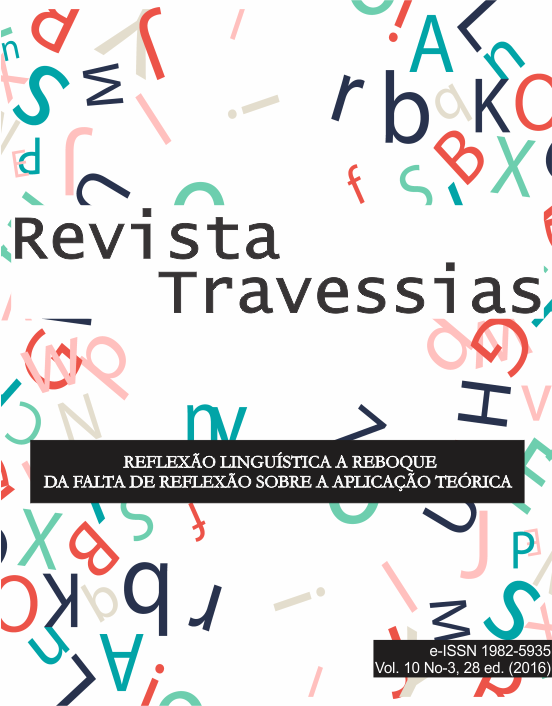Memes virtual: gender speech, dialogism, polyphony and heterogeneity enunciation
Keywords:
Virtual memes. Speech genre. Dialogism. Polyphony. Heterogeneity enunciation.Abstract
This article presents theoretical reflection and analysis on virtual memes focusing on some issues of interest in language studies, such as the notions of discourse genre, dialogism, polyphony and enunciative heterogeneity. Based on the Bakhtinian principle that language is constitutively dialogic and therefore heterogeneous, we propose here that virtual memes are essentially polyphonic genres of discourse, in which the voices of the other are manifested in various forms and contribute to the effects of Intentioned by the producer of the genus are achieved when the replication process is performed.
Downloads
References
AUTHIER-REVUZ, J. Entre a transparência e opacidade: um estudo enunciativo do sentido. Porto Alegre: EDIPUCRS, 2004.
_______. Heterogeneidades enunciativas. Cadernos de Estudos Linguísticos, Campinas, IEL, 1990, p. 25-42. (Tradução: J. W. Geraldi).
_______. Hétérogénéité montrée et hétérogénéité constitutive: des éléments pour une aproche de l’autre dans le discours. DRLAV, Paris, Université de Paris VIII-Vincennes, n. 26, 1982.
BAKHTIN, M. Estética da criação verbal. Tradução Paulo Bezerra. São Paulo: Martins Fontes. 2003.
______. Marxismo e filosofia da linguagem. 7. ed. Tradução M. Lahud e Y. F. Vieira. São Paulo: Hucitec, 1981.
______. Problemas da poética de Dostoiévski (1929). 2. ed. Trad. Paulo Bezerra. Rio de Janeiro: Forense Universitária, 1997.
BLACKMORE, S. The meme machine. Oxford: Oxford University Press, 1999.
BRAIT, B. A natureza dialógica da linguagem: formas e graus de representação dessa dimensão constitutiva In: FARACO, Carlos Alberto; TEZZA, Cristovão; CASTRO, Gilberto (Orgs.). Diálogos com Bakhtin. Curitiba: Editora da Universidade Federal do Paraná, 1996, p. 69-92.
______. Ironia em perspectiva polifônica. Unicamp : Campinas, 2000.
CAVALCANTE, M. M. & BRITO, M. A. P. Intertextualidades, heterogeneidades e referenciação. Linha d’Água, n. 24 (2), 2011, p. 259-276.
DAWKINS, R. O gene egoísta. Tradução de Rejane Rubino. São Paulo: Companhia das Letras, 1976.
FIORIN, J. L. Introdução ao pensamento de Bakhtin. São Paulo: Ática, 2006.
KOCH, I. G. V. O texto e a construção dos sentidos. 7ª ed. São Paulo: Contexto, 2003.
______. & ELIAS, M. V. Ler e compreender os sentidos do texto. São Paulo, Editora Contexto, 2010.
MARCUSCHI, L. A. Produção Textual, análise de gênero e compreensão. São Paulo: Parábola Editorial, 2008.
PONZIO, A. A revolução bakhtiniana. São Paulo: Contexto, 2011.
RECUERO, R. C. Memes em weblogs: proposta de uma taxonomia. Conexões nas Redes Midiáticas. Revista FAMECOS, Porto Alegre, n. 32, p. 23-31, abr. 2007.
SOUZA, C. F. Memes: formações discursivas que ecoam no ciberespaço. Vértices, Campos dos Goytacazes/ RJ, v.15, n. 1, jan./abr. 2013, p. 127-148.
SWALES, J. M. Genre analysis: English in academic and research settings. New York: Cambridge University Press, 1990.
Downloads
Published
How to Cite
Issue
Section
License
Creative Copyright Notice
Policy for Free Access Journals
Authors who publish in this journal agree to the following terms:
1. Authors keep the copyright and grant the journal the right of first publication, with the work simultaneously licensed under the Creative Commons Attribution License, which allows sharing the trial with acknowledgment of authorship and initial publication in this journal.
2. Authors are authorized to take additional contracts separately, for non-exclusive distribution of the work version, published in this journal (eg publish in institutional repository or as a book chapter), with acknowledgment of authorship and initial publication in this journal.
3. Authors are allowed and encouraged to publish and distribute their work online (eg in institutional repositories or on their personal page) at any point before or during the editorial process, as this can generate productive changes, as well as increase both impact and citation of the published trial (See The Effect of Free Access).
Creative Commons License
This work is licensed under a Creative Commons Attribution–NonCommercial-shareaswell 4.0 International License, which allows you to share, copy, distribute, display, reproduce, completely or part of the work, since there is no commercial purpose, and authors and source are cited.



